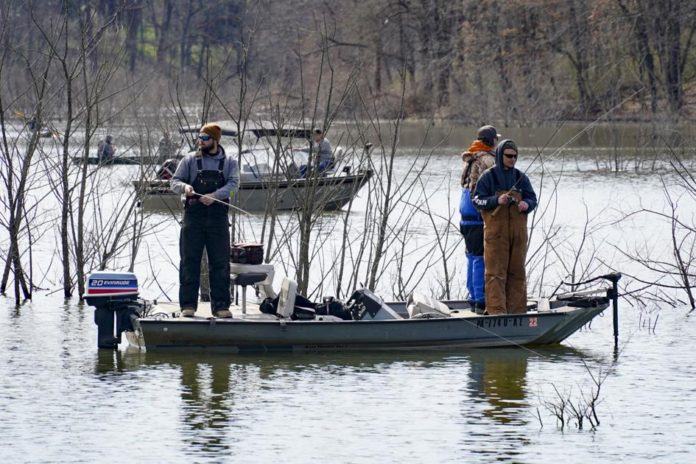AIRVILLE – Pennsylvania fishermen like Russ Collins are worried about trees.
He lives in Palmyra, Lebanon County, and is the vice president of Trout Unlimited’s southcentral region.
He wonders whether a struggling tree species could ultimately endanger one of the top fishing grounds in the country, if not the world.
He sees, first-hand, how the iconic hemlock – Pennsylvania’s state tree – is under siege and is dying off.
A stand of hemlocks in his backyard is all but gone despite efforts to combat the invasive woolly adelgid bug that slowly sucks the life from them.
He also points to a two-mile stretch of water in Dauphin County where hemlocks are dying off every 40 feet or so. It’s gotten so bad, the fallen giants have jammed up a section of Clarks Creek.
“If they continue to die like they’re doing, the water will continue to warm …,” and the fickle brook trout’s habitat will shrink, he said.
There is a direct correlation between hemlock and native trout, a species highly sensitive to water pollutants, stream erosion and warming temperatures.
The situation is particularly crucial in Pennsylvania, which has more miles of stream than any state in the lower 48. It also has at least 15,000 miles of wild trout streams and nearly 5,000 miles of stocked trout streams.
The state is renowned for its fly fishing and trout. Hemlocks are one of the great protectors of their waters.
The towering trees that often live for hundreds of years create their own ecosystems. Certain kinds of animal life, like warblers and salamanders, as well as insects and plants, depend upon them. Deer and others bed down under them for warmth in winter and to stay cool in summer.
Hemlocks often reside along streams, their vast root systems helping to stabilize water levels and prevent erosion. Their thick evergreen branches provide unparalleled, cooling shade. Native trout, for example, require waters that don’t rise above the low-60s to spawn and thrive. They also eat the insects that eat the hemlock needles that fall into the streams.
When hemlocks die, there’s nothing substantial to take their place in short order. Even optimum native options, such as red maple and yellow birch, take years to grow large enough to provide similar benefits.
And so there is a race underway, even if it is a slow and deliberate one: Ensure that hemlocks do not go the way of the American chestnut, elm and ash trees in Pennsylvania and throughout the East.
Because this is potentially more than just a tree problem.
Under attack
Woolly adelgids have been slowly killing hemlocks for nearly 50 years, from Georgia through the New England states. The rice-sized insects native to Asia have no natural enemies here and have helped kill more than 10 million hemlocks in Pennsylvania alone.
Adelgid infestations have been found in 64 of the state’s 67 counties.
And the mortality rate has only increased since the 1990s, boosted by warmer winters that encourage the adelgid to flourish.
Cherished hemlock stands in Pennsylvania’s Tuscarora State Forest have been wiped away. Same for those in Bedford and Lycoming counties and in the Pine Creek watershed in Tioga County, near the New York border. Trees in the State College area have been hit particularly hard, as well.
Even the Flight 93 National Memorial crash site is under increased vigilance because its 11-acre hemlock stand is infested. The western part of the state, particularly in Allegheny and Butler counties, have seen an adelgid surge in the past year or so.
Mostly, hemlocks deteriorate slowly from these bug attacks, taking anywhere from 4 to 10 years to die. The adelgid’s egg sacs are the most visible sign of an infestation, resembling tiny tufts of cotton on the underside of branches.
Compromised trees become spindly, brown apparitions of their former selves and provide little cover and value.
“I feel like no one is used to seeing what a healthy hemlock looks like anymore,” said Matt Kern, a forester with the state’s Department of Conservation and Natural Resources.
Hemlock woolly adelgid infects a tree in West Manchester Township. The pest has spread across all of Pennsylvania through the past 40 years, killing millions of trees.
At the same time, some researchers and environmentalists point to promise, at least as far as slowing down the insect’s march. Best practices include pesticides, bio-controls like flies and beetles that eat the adelgids and breeding programs focused on increasing pest resistance, similar to the efforts to bring back American chestnuts.
It does appear that hemlocks are not dying as quickly as once believed and that certain areas of the state have not been hit as hard by the infestation. York and other southern counties do not feature nearly as many hemlock-guarded streams as those to the north.
Meanwhile, groups like the Lancaster Conservancy continue to tend to hemlocks, such as planting more than a thousand in the past two years through their 8,000 acres in Lancaster, York, Berks and Chester counties.
The DCNR also has established a “hemlock conservation plan” to identify significant infestations and focused treatment.
Fishermen hope this all is enough to save one of the state’s biggest lures.
Those like Thom Livingston, a guide with Yellow Breeches Outfitters in Boiling Springs, believes the tree’s decline, and its relationship with trout streams, is not at a critical stage in most places.
“If we keep attacking it now we should get ahead of the game,” he said, hopeful. “If nothing’s done, we are in trouble.”
Credit: Source link































